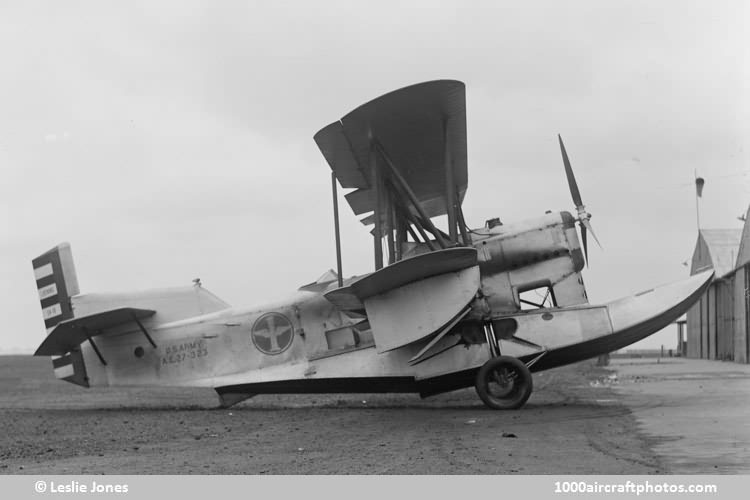06/15/2013. Remarks by Johan Visschedijk: "The introduction of the inverted Liberty engine in 1923 made possible the development of a unique form of amphibian aircraft. Where previous amphibians had been flying boats or conventional pontoon seaplanes fitted with retractable landing gear, the Loening COA-1 (Corps Observation Amphibian) utilized the high thrust line of the inverted engine to decrease the distance between the central float and the fuselage of the traditional naval single float seaplane and then faired in the space between with useful working area instead of the conventional struts and wire rigging.
The reduced distance from main float to fuselage also made it possible to fasten the wing tip floats directly to the bottom of the lower wing in the manner of biplane flying boats rather than extending them on the struts of traditional pontoon seaplanes. The retractable landing gear was hinged on the chine line of the hull/pontoon, with the wheel assemblies being rotated upward and inward into recesses in the metal hull. Half of each wheel projected out of the hull when fully retracted. Equipment was normal for an observation type, a synchronized Browning machine gun for the pilot and single or twin Lewis guns and camera and radio installations for the observer.
The XCOA-1 was one of the first aeroplanes in which applied psychology was an important design factor. Knowing the distrust with which all un-conventional designs were viewed by pilots and arch-conservative procurement officials, designer Grover C. Loening decided that the radical feature of his new fuselage/hull should be counteracted by a thoroughly familiar feature in which the pilots had full confidence if the design were to be accepted. Consequently, he chose a wooden two-bay biplane wing so similar to that of the ubiquitous DH-4 that the pilots, who could see the wings from their cockpit but not the lower portion of the unconventional hull, felt right at home.
Following test of the XCOA-1 in July 1924 (the "X" became part of the official designation after the prototype was ordered) a second prototype was ordered and was followed by nine service test COA-1s. Three of these were turned over to the Navy for use by the Navy-MacMillan Arctic Expedition of 1925. Fifteen production OA-1As, with the C-for-Corps portion of the designation deleted and featuring extensively redesigned vertical tail surfaces, followed. Of six OA-1As used for a goodwill tour to the tip of South America in 1926, one, named City of San Francisco is preserved in the National Museum of the USAF at Wright-Patterson AFB.
Nine OA-1Bs featured minor refinements, but the ten OA-1Cs could be distinguished by a new vertical tail shape that remained standard for all subsequent Army, Navy, and commercial Loening Amphibians of this model. The designation XOA-1A was originally assigned to an experimental OA-1A variant that featured an experimental inverted Wright V-1640-1 air-cooled engine and a single wheel retracting into the center line of the hull with ground stability provided by skids on the bottoms of the wing tip floats. This aeroplane was delivered as the XO-10 with no reference in the type designation to its amphibious characteristics.
The eight OA-2s of 1929 were similar to the OA-1Cs except for substitution of the inverted air-cooled Wright V-1460-1 for the obsolescent Liberty. Armament was the same as the OA-1s except that the pilot's gun was relocated in the upper left wing outside of the propeller arc.
The pictured aircraft was used to bring General Preston Brown, Commander 1st Corps Area, to New York and back, pilot was Lieutenant Richard 'Dick' E. Cobb, Army Air Corps Supply and Transportation Officer at East Boston Airport. Lieutenant Cobb was also the pilot in this additional view, taken on May 13, 1928, also at East Boston Airport. The aircraft was being prepared to fly Lieutenant Elwood R. Quesada to St. John's, Dominion of Newfoundland, Canada, as a relief pilot for Lieutenant Muir S. Fairchild, a pilot in the support of the stranded Junkers W 33 named 'Bremen', which made the first successful east-west transatlantic flight."
